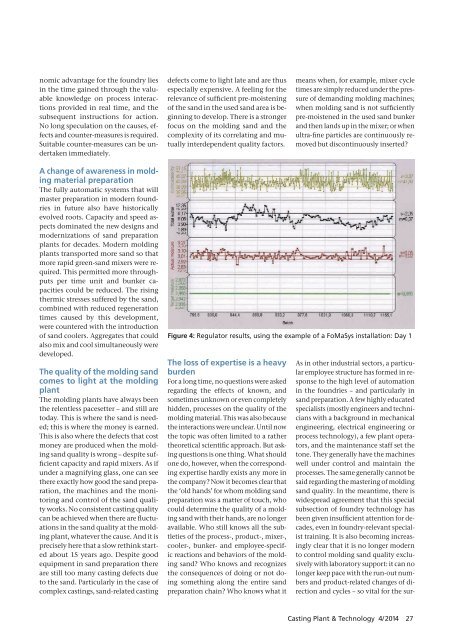CPT International 04/2014
The leading technical journal for the global foundry industry – Das führende Fachmagazin für die weltweite Gießerei-Industrie
The leading technical journal for the
global foundry industry – Das führende Fachmagazin für die
weltweite Gießerei-Industrie
Create successful ePaper yourself
Turn your PDF publications into a flip-book with our unique Google optimized e-Paper software.
nomic advantage for the foundry lies<br />
in the time gained through the valuable<br />
knowledge on process interactions<br />
provided in real time, and the<br />
subsequent instructions for action.<br />
No long speculation on the causes, effects<br />
and counter-measures is required.<br />
Suitable counter-measures can be undertaken<br />
immediately.<br />
defects come to light late and are thus<br />
especially expensive. A feeling for the<br />
relevance of sufficient pre-moistening<br />
of the sand in the used sand area is beginning<br />
to develop. There is a stronger<br />
focus on the molding sand and the<br />
complexity of its correlating and mutually<br />
interdependent quality factors.<br />
means when, for example, mixer cycle<br />
times are simply reduced under the pressure<br />
of demanding molding machines;<br />
when molding sand is not sufficiently<br />
pre-moistened in the used sand bunker<br />
and then lands up in the mixer; or when<br />
ultra-fine particles are continuously removed<br />
but discontinuously inserted?<br />
A change of awareness in molding<br />
material preparation<br />
The fully automatic systems that will<br />
master preparation in modern foundries<br />
in future also have historically<br />
evolved roots. Capacity and speed aspects<br />
dominated the new designs and<br />
modernizations of sand preparation<br />
plants for decades. Modern molding<br />
plants transported more sand so that<br />
more rapid green-sand mixers were required.<br />
This permitted more throughputs<br />
per time unit and bunker capacities<br />
could be reduced. The rising<br />
thermic stresses suffered by the sand,<br />
combined with reduced regeneration<br />
times caused by this development,<br />
were countered with the introduction<br />
of sand coolers. Aggregates that could<br />
also mix and cool simultaneously were<br />
developed.<br />
The quality of the molding sand<br />
comes to light at the mold ing<br />
plant<br />
The molding plants have always been<br />
the relentless pacesetter – and still are<br />
today. This is where the sand is needed;<br />
this is where the money is earned.<br />
This is also where the defects that cost<br />
money are produced when the molding<br />
sand quality is wrong – despite sufficient<br />
capacity and rapid mixers. As if<br />
under a magnifying glass, one can see<br />
there exactly how good the sand preparation,<br />
the machines and the monitoring<br />
and control of the sand quality<br />
works. No consistent casting quality<br />
can be achieved when there are fluctuations<br />
in the sand quality at the molding<br />
plant, whatever the cause. And it is<br />
precisely here that a slow rethink started<br />
about 15 years ago. Despite good<br />
equipment in sand preparation there<br />
are still too many casting defects due<br />
to the sand. Particularly in the case of<br />
complex castings, sand-related casting<br />
Figure 4: Regulator results, using the example of a FoMaSys installation: Day 1<br />
The loss of expertise is a heavy<br />
burden<br />
For a long time, no questions were asked<br />
regarding the effects of known, and<br />
sometimes unknown or even completely<br />
hidden, processes on the quality of the<br />
molding material. This was also because<br />
the interactions were unclear. Until now<br />
the topic was often limited to a rather<br />
theoretical scientific approach. But asking<br />
questions is one thing. What should<br />
one do, however, when the corresponding<br />
expertise hardly exists any more in<br />
the company? Now it becomes clear that<br />
the ‘old hands’ for whom molding sand<br />
preparation was a matter of touch, who<br />
could determine the quality of a molding<br />
sand with their hands, are no longer<br />
available. Who still knows all the subtleties<br />
of the process-, product-, mixer-,<br />
cooler-, bunker- and employee-specific<br />
reactions and behaviors of the molding<br />
sand? Who knows and recognizes<br />
the consequences of doing or not doing<br />
something along the entire sand<br />
preparation chain? Who knows what it<br />
As in other industrial sectors, a particular<br />
employee structure has formed in response<br />
to the high level of automation<br />
in the foundries – and particularly in<br />
sand preparation. A few highly educated<br />
specialists (mostly engineers and technicians<br />
with a background in mechanical<br />
engineering, electrical engineering or<br />
process technology), a few plant operators,<br />
and the maintenance staff set the<br />
tone. They generally have the machines<br />
well under control and maintain the<br />
processes. The same generally cannot be<br />
said regarding the mastering of molding<br />
sand quality. In the meantime, there is<br />
widespread agreement that this special<br />
subsection of foundry technology has<br />
been given insufficient attention for decades,<br />
even in foundry-relevant specialist<br />
training. It is also becoming increasingly<br />
clear that it is no longer modern<br />
to control molding sand quality exclusively<br />
with laboratory support: it can no<br />
longer keep pace with the run-out numbers<br />
and product-related changes of direction<br />
and cycles – so vital for the sur-<br />
Casting Plant & Technology 4/<strong>2014</strong> 27


















